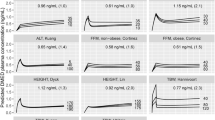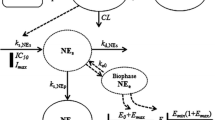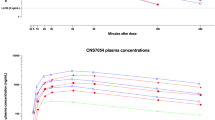Abstract
Purpose
The aim of this proof-of-concept study was to characterize the pharmacokinetics and pharmacodynamics of intranasal dexmedetomidine compared with its intravenous administration in a small number of healthy volunteers.
Methods
Single doses of 84 μg of dexmedetomidine were given once intravenously and once intranasally to seven healthy men. Plasma dexmedetomidine concentrations were measured for 10 h, and pharmacokinetic variables were calculated with standard noncompartmental methods. Heart rate, blood pressure, concentrations of adrenaline and noradrenaline in plasma, and central nervous system drug effects (with the Maddox wing, Bispectral Index, and three visual analog scales) were monitored to assess the pharmacological effects of dexmedetomidine.
Results
Six individuals were included in the analyses. Following intranasal administration, peak plasma concentrations of dexmedetomidine were reached in 38 (15–60) min and its absolute bioavailability was 65% (35–93%) (medians and ranges). Pharmacological effects were similar with both routes of administration, but their onset was more rapid after intravenous administration.
Conclusions
Dexmedetomidine is rather rapidly and efficiently absorbed after intranasal administration. Compared with intravenous administration, intranasal administration may be a feasible alternative in patients requiring light sedation.




Similar content being viewed by others
References
Hayashi Y, Maze M (1993) Alpha 2 adrenoceptor agonists and anaesthesia. Br J Anaesth 71(1):108–118
Yuen VM, Irwin MG, Hui TW, Yuen MK, Lee LH (2007) A double-blind, crossover assessment of the sedative and analgesic effects of intranasal dexmedetomidine. Anesth Analg 105(2):374–380
Yuen VM, Hui TW, Irwin MG, Yuen MK (2008) A comparison of intranasal dexmedetomidine and oral midazolam for premedication in pediatric anesthesia: a double-blinded randomized controlled trial. Anesth Analg 106(6):1715–1721
Yuen VM, Hui TW, Irwin MG, Yao TJ, Wong GL, Yuen MK (2010) Optimal timing for the administration of intranasal dexmedetomidine for premedication in children. Anaesthesia 65(9):922–929
Guidance for Industry Bioanalytical Method Validation U.S. Department of Health and Human Services Food and Drug Administration Center for Drug Evaluation and Research (CDER) Center for Veterinary Medicine (CVM) May 2001 BP http://www.fda.gov/downloads/Drugs/GuidanceComplianceRegulatoryInformation/Guidances/ucm070107.pdf
Ji QC, Zhou JY, Gonzales RJ, Gage EM, El-Shourbagy TA (2004) Simultaneous quantitation of dexmedetomidine and glucuronide metabolites (G-Dex-1 and G-Dex-2) in human plasma utilizing liquid chromatography with tandem mass spectrometric detection. Rapid Commun Mass Spectrom 18(15):1753–1760
Scheinin M, Karhuvaara S, Ojala-Karlsson P, Kallio A, Koulu M (1991) Plasma 3, 4-dihydroxyphenylglycol (DHPG) and 3-methoxy-4-hydroxyphenylglycol (MHPG) are insensitive indicators of alpha 2-adrenoceptor mediated regulation of norepinephrine release in healthy human volunteers. Life Sci 49(1):75–84
Hannington-Kiff JG (1970) Measurement of recovery from outpatient general anaesthesia with a simple ocular test. Br Med J 3(5715):132–135
Sigl JC, Chamoun NG (1994) An introduction to bispectral analysis for the electroencephalogram. J Clin Monit 10(6):392–404
Bond A, Lader MH (1974) The use of visual analogue scales in rating subjective feelings. Br J Med Psychol 1974(47):211–218
Anttila M, Penttila J, Helminen A, Vuorilehto L, Scheinin H (2003) Bioavailability of dexmedetomidine after extravascular doses in healthy subjects. Br J Clin Pharmacol 56(6):691–693
Takala A, Kaasalainen V, Seppala T, Kalso E, Olkkola KT (1997) Pharmacokinetic comparison of intravenous and intranasal administration of oxycodone. Acta Anaesthesiol Scand 41(2):309–312
Acknowledgements
Ms. Elina Kahra, Medical Laboratory Technologist, is acknowledged for skilful assistance in handling the blood samples. Ms. Teija Lemmetyinen, RN, is acknowledged for invaluable help in running the study days. This work was financially supported by Turku University Hospital research grants #13821 and #13388.
Conflict of Interest
Dr. Iirola, Dr. Aantaa and Dr. Olkkola have ongoing contract research relationships with Orion Corporation (Espoo, Finland), the original developer of dexmedetomidine. Dr. Iirola has received speaker fees from Orion Corporation (Espoo, Finland). Dr. Aantaa has been a paid consultant for Orion Corporation (Espoo, Finland) and Abbott Laboratories (Abbott Park, IL, USA), the original codevelopers of dexmedetomidine, as well as for Hospira (Lake Forest, IL, USA). Hospira has a license agreement with Orion Corporation concerning dexmedetomidine (Precedex®). Dr. Lahtinen has been engaged in contract research for Orion Corporation (Espoo, Finland). The laboratory of Dr. Scheinin has contract research relationships with Orion Corporation (Espoo, Finland) and Hospira (Lake Forest, IL, USA). Hospira has a license agreement with Orion Corporation concerning dexmedetomidine (Precedex®). Dr Scheinin has also received speaker fees and consulting fees from Orion Corporation.
Author information
Authors and Affiliations
Corresponding author
Additional information
Dr. Iirola and Dr. Vilo share equal contribution.
Rights and permissions
About this article
Cite this article
Iirola, T., Vilo, S., Manner, T. et al. Bioavailability of dexmedetomidine after intranasal administration. Eur J Clin Pharmacol 67, 825–831 (2011). https://doi.org/10.1007/s00228-011-1002-y
Received:
Accepted:
Published:
Issue Date:
DOI: https://doi.org/10.1007/s00228-011-1002-y




